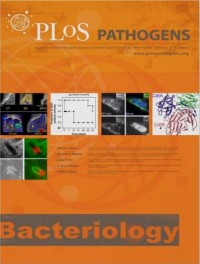PLoS Pathogens Q1
 Unclaimed
Unclaimed
Reflecting the full breadth of research on bacteria, fungi, parasites, prions and viruses, PLOS Pathogens publishes outstanding original research and commentary that significantly advance the understanding of pathogens and how they interact with their host organisms. The journal will not consider purely descriptive studies, such as those that solely identify a new genomic sequence of a related pathogen or a series of related pathogens, the isolation of pathogen variants, or a new strain or type. It has an SJR impact factor of 1,987.
PLoS Pathogens focuses its scope in these topics and keywords: virus, infection, t, viral, cells, cd, regulation, cell, host, human, ...
Type: Journal
Type of Copyright: CC BY
Languages: English
Open Access Policy: Open Access
Type of publications:
Publication frecuency: -



2025 €
Inmediate OANPD
Embargoed OA- €
Non OAMetrics
1,987
SJR Impact factor260
H Index697
Total Docs (Last Year)2097
Total Docs (3 years)47652
Total Refs10825
Total Cites (3 years)2082
Citable Docs (3 years)4.73
Cites/Doc (2 years)68.37
Ref/DocOther journals with similar parameters
Molecular Cell Q1
Cell Research Q1
Annual Review of Plant Biology Q1
Cell Host and Microbe Q1
Annual Review of Medicine Q1
Compare this journals
Aims and Scope
Best articles by citations
Anthrax, but Not Bacillus anthracis?
View moreNanobacteria: Facts or Fancies?
View moreNeutralizing Antibody Fails to Impact the Course of Ebola Virus Infection in Monkeys
View moreDirect Inhibition of T-Cell Responses by the Cryptococcus Capsular Polysaccharide Glucuronoxylomannan
View moreChange in the Editorial Leadership of PLoS Pathogens
View morePLoS Pathogens - A High-Impact Journal for Pathogen Research
View moreCorrection: A New Bacillus anthracis Found in Wild Chimpanzees and a Gorilla from West and Central Africa
View moreCorrection: A Systematic Map of Genetic Variation in Plasmodium falciparum
View moreCorrection: Alpha-Herpesvirus Infection Induces the Formation of Nuclear Actin Filaments
View moreCorrection: DC-SIGN on B Lymphocytes Is Required for Transmission of HIV-1 to T Lymphocytes
View moreCorrection: Delayed Goblet Cell Hyperplasia, Acetylcholine Receptor Expression, and Worm Expulsion in SMC-Specific IL-4Ra-Deficient Mice
View moreThe Toxoplasma Kinase ROP18: An Active Member of a Degenerate Family
View moreCorrection: Dynorphin Activates Quorum Sensing Quinolone Signaling in Pseudomonas aeruginosa
View moreCorrection: Evidence of Differential HLA Class I-Mediated Viral Evolution in Functional and Accessory/Regulatory Genes of HIV-1
View moreCorrection: Functional and Genetic Analysis of Coronavirus Replicase-Transcriptase Proteins
View moreCorrection: Listeria monocytogenes Traffics from Maternal Organs to the Placenta and Back
View moreCorrection: Population Genomics of the Immune Evasion (var) Genes of Plasmodium falciparum
View moreThe Acetobacteraceae: Extending the Spectrum of Human Pathogens
View moreA Genomic Approach to Identify Regulatory Nodes in the Transcriptional Network of Systemic Acquired Resistance in Plants
View moreWhy Provide an Opinions Section in PLoS Pathogens?
View moreDelayed Goblet Cell Hyperplasia, Acetylcholine Receptor Expression, and Worm Expulsion in SMC-Specific IL-4Ra-Deficient Mice
View moreCorrection: Stochastic Processes Are Key Determinants of Short-Term Evolution in Influenza A Virus
View moreCorrection: Structure of the Malaria Antigen AMA1 in Complex with a Growth-Inhibitory Antibody
View moreCorrection: Synergy or Independence? Deciphering the Interaction of HLA Class I and NK Cell KIR Alleles in Early HIV-1 Disease Progression
View more
Comments